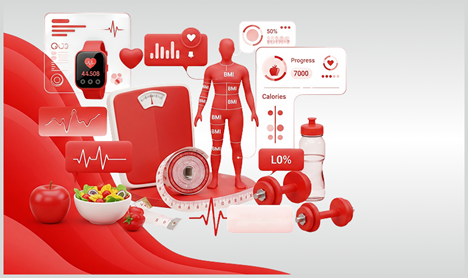Adding BMI to Wellness Tracking for More Intimate Knowledge of Health
Health is not so much a matter of exercise every day or even healthy eating.It's more about knowing and tracking the most important predictors of health in the long run. Most basic of all maybe is Body Mass Index, or BMI, a ratio of your weight to your height. When coupled with wellness tracking features such as habit trackers, mood logs, and fitness progress trackers, BMI monitoring can give a complete picture of your well-being. This process allows for personalized insights,enabling people to make informed lifestyle decisions and adopt sustainable wellness objectives.
The Importance of Tracking BMI
Tracking BMI is a critical component to know the status of your body's health. Regular BMI screening tells you whether and when you are underweight, normal, overweight, or obese. A history of such screening enables you to detect trends and risk of underlying disease before it advances. For example, regular screening can be an indicator of insidiously progressive weight gain that culminates in diabetes, cardiovascular, or joint disease. Health evaluation by BMI monitoring not only serves to define present health but also provide realistic expectations in weight management and general health.
With professionals present, if the culture of BMI monitoring is part, its potential is reached to the maximum. At V Sparkel, BMI is measured properly and monitored over time for individualizing diet and training regimen for every patient. Monitoring BMI change and other measures of health and well-being, diet, exercise regimes, and therapies for life can be controlled by dietitians and personal trainers such that change is for positive health benefit. Monitoring BMI this way is a real-time feedback device.
Welding Wellness Monitoring to BMI

Wellness tracking software such as habit trackers, diaries for health, and fitness tracking progress software complement BMI tracking since it allows you to comprehend determinants of your body mass. Monitoring activities on a weekly or daily basis like calorie consumption, exercising, water consumption, and sleeping helps you comprehend how lifestyle determinants influence BMI. For instance, weight gain by BMI can be due to experiencing periodic activity or food cravings, whereas better habits are usually the work of daily tendencies. Incorporating such a process is so healthy data analysis isn't merely a number, yet it also considers the larger picture of individuals' lifestyles and tendencies.
Monitoring moods is also applicable if followed by BMI measurement. Emotional deprivation or distress will affect weight management, and observation of such behaviors and BMI figures will identify body composition issues in jeopardy. Armed with understanding of the interrelation between mental wellbeing and BMI, one can now select tactics that respect both physical and emotional health in tandem. V Sparkel dismantled this synergistic complementarity by fusing monitoring of BMI with wellbeing monitoring to create an integrated, customized master plan for healthy living.
Advantages of BMI and Wellness Monitoring Unifying
Unifying BMI and wellness monitoring has the following advantages to successful Long-term healthcare programs. Firstly, intervention is initiated earlier using tracking weight gain or loss indicators that can initiate readjustment of activity or food. Two, this integration does require greater accountability since monitoring daily activities with the aid of BMI makes measurable data of improvement or area for improvement possible. Participants will remain more interested if they can perceive distinct connections between the activities they are engaged in and BMI and overall health consequences.
Personalized health information is another advantage. Processing health data with built-in BMI and well-being tracking allows practitioners to provide individualized interventions depending on specific requirements. From a specific diet regime, tailored exercise plan, or stress reduction regime, such an intervention ensures that with each move in the direction of providing optimized body mass index measurement and overall health, no stone is left unturned. The presence of such monitoring systems in centers like V Sparkel makes individuals feel empowered to take bold, clear-headed, and long-term control over their own health.
Conclusion
Full-view wellness tracking and BMI tracking integration is an engaging way to understand and maximize well-being. With the inclusion of BMI tracking, health data tracking, and habit tracking, users are given actionable insights that guide diet, exercise, and lifestyle. We aim to engage them at V Sparkel with customized recommendations to enable body mass index measurement to accurately reflect progress toward lasting well-being and healthier living with a more balanced life.
FAQs
1. Which health metrics should I track with BMI?
Track steps, heart rate, sleep, and calorie intake for a complete picture of your health.
2. What is BMI and why would I use it?
BMI (Body Mass Index) calculates weight relative to height and tells you whether you're underweight, normal, or overweight for health tracking.
3. What BMI is considered underweight, normal, overweight, or obese?
No, BMI itself does not take into account lifestyle or muscle mass; coupled with wellness tracking, it gives a better picture.
4. Can the pairing of BMI and wellness data prevent health threats?
Yes, early indication of trends like weight gain, sleep issues, or physical inactivity can reduce risks of chronic conditions.
